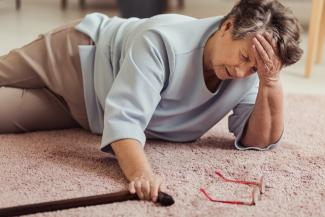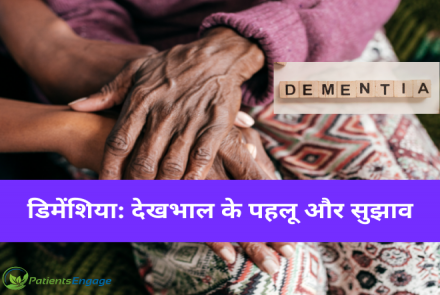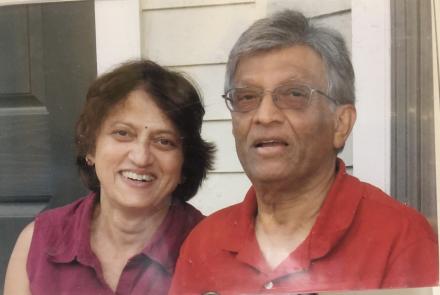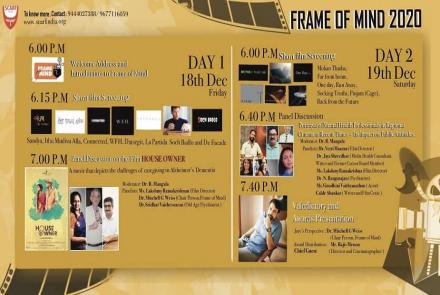
Ms. Ayush Chandra and Ms. Sradha Madan Ray under the guidance of DEMCARES, SCARF India write about the leading causes for falls in persons with dementia and how caregivers can prevent these falls.
According to WHO risk of falls in old age increases due to several factors such as changes in physical function, sensory input, and cognition. For a patient with cognitive impairment the risk is doubled and can lead to more complications (Scala G & Kraemer, 2009).
Being aware of the factors that lead to falls in persons with dementia can help prevent them. Some causes can be similar to the ones that affect elderly due to the normal process of aging but others (discussed below) are specific to people with dementia.
Related Reading: Preventing Falls in Older People
Intrinsic risk factors
Intrinsic risk factors are factors that refer to possible health conditions associated with aging, which also includes effect of medications on an individual.
Balance and Gait: Some conditions that directly affect balance and gait include stroke, Parkinson’s disease, arthritis, neuropathy, neuromuscular degeneration or vestibular disease.
Delayed motor reaction time: Due to slow reaction time and sometimes delayed response, elderly are prone to falls. For example, if there is a situation where an elderly skips a foot or slip due to any obstacle he or she might not be able to grasp something quickly in order to find their balance back which might lead to a fall.
Medications: Use of multiple medications, interaction between different medications and side-effects can be leading causes for falls. Sometimes, psychiatric medications used to manage challenging behaviour in dementia can increase falls due to drowsiness or fluctuations in blood pressure. Hence, use of these medications need to be monitored carefully or avoided if possible by using non-pharmacological interventions instead.
Visual impairment: Glaucoma, macular degeneration and retinopathy increase the risk of falls. Bifocals and trifocals can also increase the risk of falls. The patient might not be able to see obstacles in their way clearly or judge the height of structures like steps and may have a fall.
Cardiovascular causes: Orthostatic hypotension [fall in the blood pressure (BP) when on getting up from bed or standing up], postprandial hypotension (fall in the BP after a meal), cardiac arrhythmias (irregular heart rhythms), carotid sinus syndrome (increased sensitivity of a sensor in the neck), and structural heart disease (such as valve disease) are the leading reasons for the falls among elderly. Paying attention to these conditions in people with dementia can also explain increased falls in this population.
Cognitive problems: Dementia increases the likelihood of falls due to the inability of persons with dementia to respond to the surrounding effectively. Changes in the environment or changes in their routine can be hard to adapt to and confuse the patient while they navigate their environment. Misperceptions of stimuli in their environment can also cause them to either get agitated or ignore potential risks that might cause falls.
Extrinsic risk factors
Extrinsic risk factors refer to the factors or conditions related to the surroundings or environment of an individual which can have an direct impact on the individual.
Lighting: Poor lighting can be a high risk to any elderly person. Low luminance of existing lights or lamps can impair vision. Eyesight deteriorates with age, optimal lighting will be necessary to compensate for this impairment in places that the patient frequently uses. Too much light can also be problematic as elderly persons are sensitive to bright lights and this can impair vision as well.
Architecture/design: Poorly constructed stairs can lead to falls. Stairs with lack of support, which are too steep or have confusing patterns on them that make depth perception very difficult for people with dementia are problematic. Short doorways (less than about 2 meters) are common in old houses and cottages which can be responsible for falls among elderly. Lack of support structures in bathrooms and toilets also lead to falls.
Clothing: Poorly fitted footwear and shoes with low friction against floor are leading causes for falls. Tight fitting clothing that restricts movement or clothes that are too loose increases the risk of tripping and can also cause falls.
Walking aids: Lack of equipment/aids such as walking sticks or walking frames (such as Zimmer frames) or inappropriate walking aids that don’t meet the needs of a particular individual can lead to falls.
Interventions
A Multifactorial approach needs to be taken into consideration when one aims to reduce the occurrence of falls in persons with dementia. This has been reflected in many studies in community living facilities and homes and has shown promise in reducing falls (Salminen, Vahlberg, & Sihvonen, 2008), (RosendHL, Witt, Szmola, Bhatia, Schulz, & Lohr, 2008). Some factors that can be useful to intervene with are:
- Caregiver/Staff Psychoeducation – Building awareness among caregivers about the different factors that people should look out for as highlighted in this article is the first step towards prevention.
- Physical activity – increasing physical activity and building strength can improve steadiness and improve gait. Physiotherapist and occupational therapists can help identify individual mobility needs and create treatment plans around this.
- Medication management – Regularly reviewing medications with your general physicians, psychiatrists and neurologists is very important. Removing medications that are not of any use currently and requesting more information on the medications that your loved one is currently on can help understand and prevent falls.
- Environmental assessment-
- Ensure adequate lighting by limiting shadows, reducing glare
- Provide visual contrast in order to define objects from the background. Using solid colors with no patterns to decrease confusion and avoiding black surfaces on the floor (like dark rugs) which might be misperceived as holes on the floor can be useful.
- Keeping pathways clear of obstructions, keeping surfaces dry and non-slippery is important. Rugs/floor surfaces with low friction cause poor traction and individual instability. All surfaces should have an adequate grip both for bare feet as well shoes in order to prevent slipping.
- Enhance accessibility by keeping important items at easy-to-reach places, using firm mattress, using bed with low height and use of simple equipment if necessary and improve accessibility.
- Increased bathroom safety by using non-slippery floors, use of bath chair, use of proper lighting in the area and installing grab rails can reduce falls.
- Ensuring safe footwear i.e. using footwear of proper fit, adequate grip, weather appropriate and Velcro closures can reduce falls. Rubber soles with ribs normally have a high friction coefficient, so are preferred for most purposes.
- The stairs should be spaced widely with low risers, and surfaces should be slip-resistant. Softer surfaces can help limit impact injuries by cushioning loads.
- Grab bars and hanging straps should be supplied plentifully, especially in critical areas where users may be vulnerable.
- Clothing should fit the patient well, without trailing parts (hems falling below the heel or loose shoe strings) which could snag with obstacles.
- Elderly people can be sensitive to loud noises which can lead to distress and confusion therefore causing them to want to ‘escape’ from that place in a rush which could make them stumble over obstacles present around resulting in falls. Monitoring noise levels is key.
- Olfactory stimulation with lavender odor in elderly nursing home residents has shown to reduce falls and agitation. Incorporating this into the environment can help as well.
Person centered approach
Keeping individual needs in mind while prioritizing fall reduction and injury prevention appear to have the most success. Assessing the individual’s strengths and weaknesses to develop fall prevention plans that address specific risk factors (for this individual) can help prevent injuries. It should also be noticed that while developng a fall prevention strategy, an individual’s socio-cultural context and the immediate environment should be taken into consideration for the strategy to be effective (Gillespie, Gillespie, Robertson, Lamb, Cumming, & Rowe, 2003).
Conclusion
This article contains some suggestions that are based upon various research studies and also out of individual experiences. There is significant evidence of higher instances of falls among persons with dementia and it is important to prevent it as it could potentially lead to further distress, both for the caregiver and the loved one. Having said that, one should also understand that the occurrence of a fall is also at times situation specific and it may not always be possible to prevent it. The most appropriate response following a fall is to immediately consult with the clinician while simultaneously using the above suggestions to prevent it from occurring again. Moreover, the caregiver is the one who understands their loved ones better than anyone else, and can definitely provide a better estimation about the effectiveness of any fall prevention strategy. Therefore it is important to collaboratively work with your healthcare provider and create a sustainable and effective multifactorial strategy to prevent future falls.
References
- Gillespie, L., Gillespie, W. J., Robertson, M. C., Lamb, S. E., Cumming, R. G., & Rowe, B. H. (2003). Interventions for preventing falls in elderly people. PubMed.gov.
- RosendHL, J., Witt, H., Szmola, R., Bhatia, E., Schulz, H., & Lohr, M. (2008). Chymotrypsin C (CTRC) variants that diminish activity or secretion are associated with chronic pancreatitis. PubMed.gov, 78-82.
- Salminen, M., Vahlberg, T., & Sihvonen, S. E. (2008). Effects of risk-based multifactorial fall prevention program on maximal isometric muscle strength in community-dwelling aged: A randomized controlled trial. PubMed.gov, 487-493.
- Scala G, M., & Kraemer, T. (2009). Fall management in Alzheimer-related dementia: a case study. PubMed.gov, 181-189.















